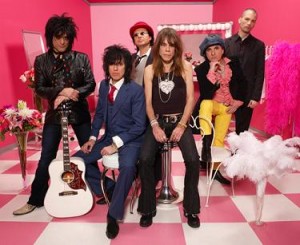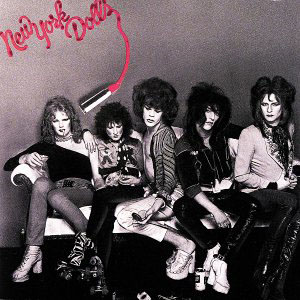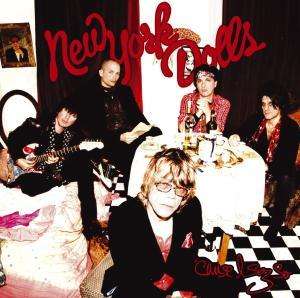 Predating punk by a few years, the New York Dolls’ blues-y glamour rock bridged the gap between the Rolling Stones early ‘60s primitivism and the Sex Pistols late-‘70s ruff ‘n tumble amateurism. Lascivious androgynous singer, David Johansen, blurted out defiant lyrics with snot-nosed adolescent authority, creating a tremendous furor his frenzied combo magnanimously embellished. Wearing tight skinny-legged trousers and sporting a devilishly smirked grin, the charismatic Johansen was the perfect greased-up bubble-lipped swivel-hipped Mick Jagger clone posing as a diabolical warlock onstage.
Predating punk by a few years, the New York Dolls’ blues-y glamour rock bridged the gap between the Rolling Stones early ‘60s primitivism and the Sex Pistols late-‘70s ruff ‘n tumble amateurism. Lascivious androgynous singer, David Johansen, blurted out defiant lyrics with snot-nosed adolescent authority, creating a tremendous furor his frenzied combo magnanimously embellished. Wearing tight skinny-legged trousers and sporting a devilishly smirked grin, the charismatic Johansen was the perfect greased-up bubble-lipped swivel-hipped Mick Jagger clone posing as a diabolical warlock onstage.
Surviving the drug-addled ‘70s, Johansen and guitarist Syl Sylvain proved resilient coming back touring and recording a few albums nearly thirty years after forming the Dolls. Amazingly, even in his late fifties, Johansen continues to lustily sneer through new tunes like a spoiled brat. In fact, the best thing about the Dolls is they’ve never changed. Fully confident in their musical ability, aging mannequins Johansen and Sylvain never had it easy and suffered a few deaths along the path to stardom.
Dressed in drag on their eponymous ’73 debut (produced by obliging studio wiz Todd Rundgren), the high-heeled makeup-caked lipstick-reddened quintet identified with the transvestite social misfit dirtying-up raging manifesto, “Personality Crisis.” Masterful guitarist, Johnny Thunders, a traumatic junkie-to-death, had the seeds planted for his best-known solo tune, “You Can’t Put Your Arms Around A Memory,” on the poignantly balladic acoustical Johansen original, “Lonely Planet Boy.” And the deliriously infectious novelty, “Trash,” evoked the Dolls mashed-up Bowery seediness in typical dungy fashion.
Then came another dazzling protopunk artifact, ‘74s delightfully nostalgic Too Much Too Soon. Produced by seasoned Shangri-La’s impresario, Shadow Morton, co-composers Johansen-Thunders increased the flashy glimmer-pop pandemonium and gave a few popular ‘50s/ ’60s numbers a shrewdly schizoid spin. Bamboozled Stones-derived kicker, “Puss ‘n Boots,” reveled in cheesy bubblegum-styled buffoonery. And ranted rallying cry “Who Are The Mystery Girls?” tingles nerve endings before Archie Bell & the Drells soulful “There’s Gonna Be A Showdown” readies for battle.
Following an extended layoff that found Johansen making big screen appearances, drafting worthy solo projects, and receiving peculiar aboveground fame under pseudonym Buster Poindexter (whose Uptown Horns-assisted calypso, “Hot Hot Hot,” became an overdone wedding, banquet, and karaoke staple), the remaining New York Dolls re-formed in ’04. During the interim, Syl Sylvain kept busy releasing a self-titled ’79 solo breakthrough and its fine ’81 follow-up, Syl Sylvain & the Teardrop. But Thunders (whose post-Dolls punk group, the Heartbreakers, received major plaudits) and drummer Jerry Nolan would soon die, the former under strange narcotic circumstances and the latter from a pneumonia-induced stroke. To add insult to injury, original depression-bound bassist, Arthur Kane, then succumbed to leukemia after the Dolls first reunion concert.
But whatever doesn’t kill you only makes you stronger and the Johansen-Sylvain-led New York Dolls (rounded out by Hanoi Rocks bassist Sami Yaffa, guitarist Steve Conte, and drummer Brian Delaney) came back strong with ‘06s ambitiously fulfilling (and teasingly titled) One Day It Will Please Us To Remember Even This. Its plushy pink-on-black cover art, uproarious femme fatale attitude, and sexually skewed fixations nicely duped their stylishly sinister ‘70s sleaze. Busily beat-driven bustle, “We’re All In Love,” found Johansen insistently yelping ‘jump around the stage like a teenage girl’ and confronting 9-to-5ers with the taunting ‘they go to work/ we got to play.’ A “Lust For Life”-nipped groove propels acrobatic hoedown, “Dance Like A Monkey.” And that same mischievous pagan ‘monkey,’ Johansen himself, reappears ‘in a dress’ on the odious rogue rampage, “Fishnets & Cigarettes.” Plaintive contemplation “I Ain’t Got Nothin’” counters shuffling Farfisa ditty “Rainbow Store.”
 Retaining their ruffian outlaw stance, the Dolls returned for ‘09s inordinately diversified Cause I Sez So. Johansen’s snootily pouted demands toughen the smokin’ title track and his great emotional depth reinforces the twin guitar-fueled “My World.” Hysterical broken-down romantic dalliance, “Better Than You,” recalls pre-Beatles balladeer Gene Pitney. Lowdown broke-dick rudimentary post-World War II blues dispatch, “This Is Ridiculous,” and twanging spaghetti Western-informed whistler, “Temptation To Exit,” offer two extremes. And if the cryptically surreal “Drowning” reminds some of the Animals early R & B recordings then the harmonica-doused “Nobody Got No Bizness” surely recaptures J. Geils Band in their prime. Strangely, a becalmed ska version of “Trash” revisits the Specials giddily portentous Brit hit, “A Message To You Rudy.”
Retaining their ruffian outlaw stance, the Dolls returned for ‘09s inordinately diversified Cause I Sez So. Johansen’s snootily pouted demands toughen the smokin’ title track and his great emotional depth reinforces the twin guitar-fueled “My World.” Hysterical broken-down romantic dalliance, “Better Than You,” recalls pre-Beatles balladeer Gene Pitney. Lowdown broke-dick rudimentary post-World War II blues dispatch, “This Is Ridiculous,” and twanging spaghetti Western-informed whistler, “Temptation To Exit,” offer two extremes. And if the cryptically surreal “Drowning” reminds some of the Animals early R & B recordings then the harmonica-doused “Nobody Got No Bizness” surely recaptures J. Geils Band in their prime. Strangely, a becalmed ska version of “Trash” revisits the Specials giddily portentous Brit hit, “A Message To You Rudy.”
What changes differentiate Cause I Sez So from One Day?
SYL SYLVAIN: We adapt songs from our live show and performing arts period. Some people spend a whole day on one note. We try to finish an entire album in one day. We procrastinate right down to the last minute – get in the studio and play whatever feels good. We work organically. It’s not rocket science. We know the Blues. If you take the Beaujolais what you get is three chord Blues progressions that could be interpreted forever – improvised solos. The show’s different every night like the Blues.
Who were your formative influences?
Eddie Cochran was the real deal. He could write ‘em, sing ‘em, play guitar. He looked good doing it. When punk started, Sid Vicious did “C’mon Everybody.” ‘50s rockers stretching from Little Richard to early ‘60s girl groups like the Shangri-La’s and Ronettes mixed with T. Rex. When David first introduced “Looking For A Kiss,” it wasn’t like when he first played it. I T-Rexed the shit out of it. We melanged everything together and became this skyscraping soup of things we loved. It turned out to be the Dolls. We opened up doors and smashed the walls. The norm was stadium rock operas. It got so damn boring. We had a Little Rascals approach. What could we do? We got makeup and put on a show. We thought if it lasted two weeks, it’d be great. We became East Village darlings. England put us on the centerfold of their biggest papers. We became stars overnight. But we got our asses kicked and it took three years to get a record contract. Once we got signed that was it – Talking Heads, Blondie, Patti Smith, the Ramones. And that’s only New York. Across the pond, Joe Strummer watched us on BBC. The whole scene changed. We spawned bands and a whole generation of clothes, style, fashion. Clubs opened up. We now have longhairs next to super-punks who’d never talk to each other at shows.
Your only competition may’ve been Bomp! Records.
We spawned Greg Shaw’s Bomp! There’s always good bands if you keep eyes open. Bands still complain, which never changed. Record labels complained about the ghetto box with the cassette player, radio, and speakers. On Friday, I’d tape the Top 40 so I wouldn’t have to buy it. Today, it’s downloading. Industry never wants to embrace change and we were all about change. You have to have a vision and not wish you were born thirty years ago. There were no clubs. We had to invent places or steal them from Velvet Underground and Andy Warhol. They didn’t have open arms at the time. We wore makeup but weren’t gay. We’d sell out Max’s Kansas City’s performance space twelve times in six nights – which was amazing. We’d get 86’ed downstairs for smoking a joint, then go play upstairs.
You did have a profound fashion influence.
Johnny Thunders was wearing motorcycle jackets and ripped-up jeans way before the Ramones.
Thunder’s Heartbreakers never got the exposure they deserved.
I taught Johnny to play guitar in ’69. We all went to Newtown High together and were getting thrown out because the mainstream thought we were gay wearing bellbottoms. So we went to Manhattan’s Quinones school for young professionals – models and musicians. My first band was the Pox, as in ‘catch the Pox at Greenwich Village.’ Johnny wanted to do bass because it only had four strings. Then he learned lead guitar and I moved to rhythm. We’d hang out at Nobody’s on Bleecker Street. Jimmy Page and Rod Stewart were there grabbing our girls. We met Arthur Kane. He had a bad time with his father in Long Island. He moved in with drummer Billy Murcia’s mom who rented out rooms in Queens. He had a great record collection. We started jamming. The nucleus was Billy, Johnny, Kane, and myself. Another renter was a Colombian immigrant like the Murcia’s. He got a job, moved to Manhattan, and told us about a cool guy on 6th Street who played harmonica and sang. That’s how we got Johansen.
We broke up in ’75 but were individually successful, unlike other bands who didn’t have that luxury. I got signed by RCA. But no one’s gonna sign a super junkie. The only thing I’d take away from the Dolls was heroin. There’s such a thing as an instant junkie. We were so popular everyone wanted to hob-knob. We were naïve and open to drugs. Show biz is nasty. I had to stop seeing Johnny onstage. He was young, clean, and fun before that.
Any new bands you like?
We’re on tour with Black Joe Lewis from Austin. They mix Motown and Blues like Muddy Waters with Wilson Pickett horns. I dig everything that’s good but too much of the same thing gets me down. They’re a breath of fresh air in a sea of mediocrity.